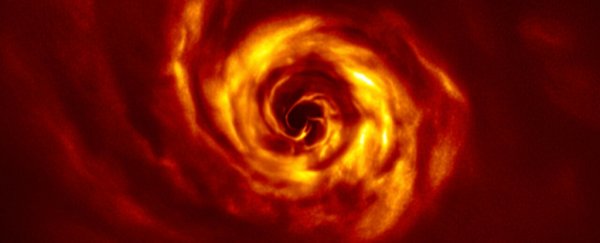A swirling, twisted cloud of dust and gas over 530 light-years away isn't just a tumultuous wonder. It's a new piece of the puzzle as to how planets grow from tiny grains to giant globes.
Astronomers have obtained breathtaking new near-infrared images of the protoplanetary disc around the young star AB Aurigae. These images show spiraling disturbances the researchers believe are caused by planets coming together from the dust.
"In the early stage of planet formation, hydrodynamical simulations indicate that the accretion process generates at the planet location an inner and outer spiral pattern due to Lindblad resonances induced by disc-planet interactions," the researchers wrote in their paper.
"While this crucial step is well documented by theoretical works, observational evidences are rare and not fully conclusive."
The new images are some of the best we've seen yet of this process in action.
Planetary formation is a fascinating process. First, a star needs to form, spooling a giant disc of dust and gas which feeds into it. When it's done, astronomers think the remaining disc starts clumping together to form other chunky bits found in planetary systems - asteroids, comets, dwarf planets, and, of course, planets.
First, electrostatic forces bring tiny clumps of cold material together. Then, as these clumps grow in size, they start generating enough gravitational power to attract more clumps, creating a dense, compact object.
During this process, the orbits of dust particles around the forming planet become perturbed, and the shape of their orbit grows elliptical, creating an oscillation between their closest and farthest point.
If this oscillation is a multiple of the particle's orbital period, it creates a resonance - called a Lindblad resonance - that should generate a spiral pattern.
This resonance, astronomers believe, is responsible for the spiral arms of massive galaxies. But what's writ large in the Universe is often also writ small. We've seen the same physics at play in Saturn's rings, and it should be observable around forming planets, too.
Except, protoplanetary discs aren't easy to observe. They're far away, and often the light of their star is so bright it obscures small features that might reveal planetary formation processes.
This is where AB Aurigae comes into the picture. It's one of the closest stars of its kind - very young, less than 10 million years old, and surrounded by a thick protoplanetary disc. In 2017, observations with the Atacama Large Millimeter/submillimeter Array (ALMA) revealed rough spiral shapes that could be the much sought-after signatures of planet formation.
So, an international team of astronomers went in for a closer look. Using the SPHERE facility attached to the Very Large Telescope in Chile, they took high-contrast observations of AB Aurigae in near-infrared in December 2019 and January 2020.
These resulted in the deepest images of the star we've seen yet, capturing fainter light from smaller grains of dust. And, combined with the earlier ALMA data, these revealed an S-shaped disturbance in the protoplanetary disc that looks a lot like the spiral density waves we'd expect to see propagating from an accreting protoplanet.
Above: The disc around AB Aurigae; on the right, a zoomed-in version of the central part of the image.
"The twist is expected from some theoretical models of planet formation," said astronomer Anne Dutrey of the Astrophysics Laboratory of Bordeaux in France.
"It corresponds to the connection of two spirals - one winding inwards of the planet's orbit, the other expanding outwards - which join at the planet location. They allow gas and dust from the disc to accrete onto the forming planet and make it grow."
This putative protoplanet seems to be forming at a distance from its star roughly equivalent to Neptune's distance from the Sun. Its exact size is hard to gauge, but the team estimates based on a previous calculation of accretion rates that it clocks in around 4 and 13 times the mass of Jupiter.
It's not a fully confirmed result yet. But it does indicate that AB Aurigae is a promising candidate for follow-up observations with more powerful telescopes that are currently under construction.
These could confirm that what we are looking at is, indeed, a giant planet in the process of formation, and to calculate its mass with greater precision.
The research has been published in Astronomy & Astrophysics.

